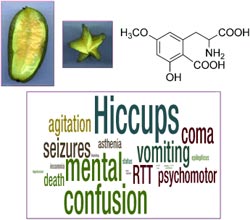Sweet Poison – Star fruit neurotoxin identified

<br>
This fruit contains a substance that is a deadly neurotoxin for people with kidney disease. Brazilian researchers have now isolated and identified this neurotoxin. As they report in the journal Angewandte Chemie, it is an amino acid similar to phenylalanine.
People suffering from chronic kidney disease have to avoid eating star fruit if they value their lives. Around the world, many cases have been documented in which ingestion of the yellow star-shaped fruit led to poisoning of dialysis patients and people with kidney disease.
There are a variety of symptoms: from intractable hiccups, vomiting, weakness, mental confusion, and psychomotor agitation, to unusually long-lasting epileptic seizures, coma, and death. In acute cases, only hemodialysis can save the patient.
It is clear that star fruit contains an unidentified neurotoxin that healthy people clear out through the kidneys without problems. In those with kidney disease, however, the toxin accumulates and can eventually enter the brain. A team at the University of São Paulo (Brazil) has now been able to unmask the culprit.
To do this, scientists led by Norberto Garcia-Cairasco and Norberto P. Lopes modeled star fruit poisoning in animals. They gave either crude extracts of star fruit to animals with experimental kidney disease (to mimic the patient´s ingestion) or injected extracts of star fruit into the brains of healthy rats, inducing the behavioral and electrographical seizures typical of star fruit poisoning.
The extracts were fractionated by means of chromatographic procedures and each individual fraction tested for activity. Active fractions were then chromatographically separated and tested again. This process was repeated until a single substance responsible for the seizures was isolated. The researchers named it caramboxin.
By using a variety of spectroscopic techniques, the scientists were able to determine the structure of caramboxin. The main structure of the neurotoxin resembles that of the amino acid phenylalanine. In contrast to the natural amino acid, the phenol ring of the toxin is also bound to extra ether, alcohol, and acid groups.
Further tests revealed that caramboxin acts on AMPA and kainate receptors, two important glutamate-controlled neurotransmitter receptors of the central nervous system. This causes hyperexcitability in the brain, resulting in the typically observed seizures, which showed neurodegenerative effects in the study.
About the Author
Dr. Norberto P. Lopes is Professor of Organic Chemistry at Faculdade de Ciências Farmacêuticas de Ribeirão Preto at the University of São Paulo (FCFRP-USP), is the Task Leader for the Research Support Center in Natural and Synthetic Products (NPPNS/USP), and has been working in natural product chemistry and mass spectrometry for over 15 years. He is currently Head of the Physics and Chemistry Department of the FCFRP and board member of the Brazilian Chemical Society and Brazilian Mass Spectrometry Society.
Author: Norberto P. Lopes, University of São Paulo (Brazil), mailto:npelopes@fcfrp.usp.br
Title: Elucidating the Neurotoxicity of the Star Fruit
Angewandte Chemie International Edition, Permalink to the article: http://dx.doi.org/10.1002/anie.201305382
Media Contact
More Information:
http://pressroom.angewandte.org.All latest news from the category: Life Sciences and Chemistry
Articles and reports from the Life Sciences and chemistry area deal with applied and basic research into modern biology, chemistry and human medicine.
Valuable information can be found on a range of life sciences fields including bacteriology, biochemistry, bionics, bioinformatics, biophysics, biotechnology, genetics, geobotany, human biology, marine biology, microbiology, molecular biology, cellular biology, zoology, bioinorganic chemistry, microchemistry and environmental chemistry.
Newest articles

Silicon Carbide Innovation Alliance to drive industrial-scale semiconductor work
Known for its ability to withstand extreme environments and high voltages, silicon carbide (SiC) is a semiconducting material made up of silicon and carbon atoms arranged into crystals that is…

New SPECT/CT technique shows impressive biomarker identification
…offers increased access for prostate cancer patients. A novel SPECT/CT acquisition method can accurately detect radiopharmaceutical biodistribution in a convenient manner for prostate cancer patients, opening the door for more…

How 3D printers can give robots a soft touch
Soft skin coverings and touch sensors have emerged as a promising feature for robots that are both safer and more intuitive for human interaction, but they are expensive and difficult…





















